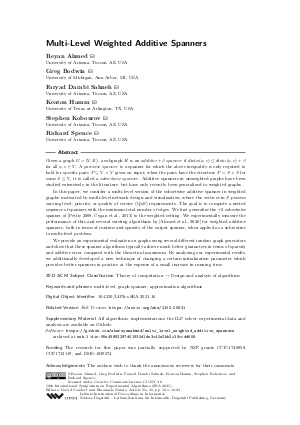@InProceedings{ahmed_et_al:LIPIcs.SEA.2021.16,
author = {Ahmed, Reyan and Bodwin, Greg and Sahneh, Faryad Darabi and Hamm, Keaton and Kobourov, Stephen and Spence, Richard},
title = {{Multi-Level Weighted Additive Spanners}},
booktitle = {19th International Symposium on Experimental Algorithms (SEA 2021)},
pages = {16:1--16:23},
series = {Leibniz International Proceedings in Informatics (LIPIcs)},
ISBN = {978-3-95977-185-6},
ISSN = {1868-8969},
year = {2021},
volume = {190},
editor = {Coudert, David and Natale, Emanuele},
publisher = {Schloss Dagstuhl -- Leibniz-Zentrum f{\"u}r Informatik},
address = {Dagstuhl, Germany},
URL = {https://drops.dagstuhl.de/entities/document/10.4230/LIPIcs.SEA.2021.16},
URN = {urn:nbn:de:0030-drops-137885},
doi = {10.4230/LIPIcs.SEA.2021.16},
annote = {Keywords: multi-level, graph spanner, approximation algorithms}
}

 Creative Commons Attribution 4.0 International license
Creative Commons Attribution 4.0 International license

























